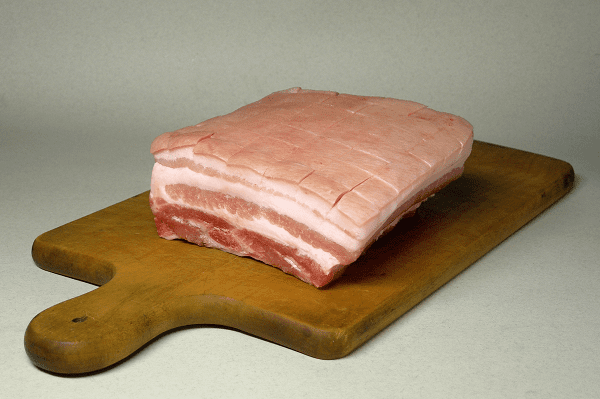Pork- Pork is the culinary name for meat from domestic pigs (Sus scrofa domesticus), which are raised and bred for their meat. It is one of the most widely consumed and versatile meats in the world. Pork can be found in various cuts and forms, including pork chops, pork tenderloin, pork ribs, ground pork, and more. Some common pork dishes and products include bacon, ham, sausages, pork roast, and pork belly.
Pork is a good source of protein and various essential nutrients, including vitamins like B vitamins (especially B1, B2, B3, B6, and B12), and minerals such as iron, zinc, and selenium. However, it’s important to consume pork in moderation, as it can also be high in saturated fats and cholesterol, which can be unhealthy if consumed excessively.
Pork is a popular meat in many cuisines around the world, and its preparation methods and flavorings vary widely by region. It can be grilled, roasted, braised, or fried, and it is often seasoned with a variety of herbs and spices. Pork is a key ingredient in dishes like pulled pork, pork chops with applesauce, pork stir-fries, and more.
It’s essential to ensure that pork is properly cooked to kill any harmful bacteria or parasites that may be present in raw pork, such as Trichinella spiralis, which can cause trichinosis. Cooking pork to a safe internal temperature of at least 145°F (63°C) is recommended.
Please note that dietary preferences and restrictions, such as religious or cultural dietary laws, may affect whether or not an individual or community consumes pork.
What is Pork
Pork is a type of meat that comes from domestic pigs (Sus scrofa domesticus). It is a commonly consumed meat around the world and is a significant part of various culinary traditions. Pork is derived from the flesh of pigs and is available in various cuts and forms. Some popular cuts of pork include pork chops, pork loin, pork belly, pork shoulder, and pork ribs. Pork is used to make a wide range of products, including bacon, ham, sausages, and more.
Pork is a good source of protein and provides essential nutrients such as vitamins (particularly B vitamins like B1, B2, B3, B6, and B12) and minerals (like iron, zinc, and selenium). However, it is also known for its relatively high fat content, including saturated fats, which can be unhealthy if consumed excessively. Therefore, it’s advisable to consume pork in moderation as part of a balanced diet.
The preparation and cooking methods for pork vary widely across cultures and cuisines. It can be roasted, grilled, pan-fried, braised, or used in various recipes. Some popular pork dishes include pork tenderloin, pork stew, pork ribs, and dishes like pulled pork or pork chops with various seasonings and sauces.
It’s important to ensure that pork is cooked thoroughly to a safe internal temperature to eliminate any potential health risks associated with undercooked pork, as it can harbor harmful bacteria or parasites. The recommended safe internal temperature for pork is at least 145°F (63°C).
It’s worth noting that dietary choices and restrictions, such as religious or cultural beliefs, can significantly influence whether individuals or communities include pork in their diets.
Who is Required Pork
“Pork” is not the name of a person or an individual. In my previous responses, I provided information about pork as a type of meat that comes from domestic pigs. Pork is a common food item and ingredient in various culinary dishes. If you have a specific question or if you are looking for information about a particular person or topic related to pork, please provide more details, and I will do my best to assist you.
When is Required Pork

“Pork” is not something that occurs at a specific time. Pork is a type of meat that comes from domestic pigs and is available year-round. You can purchase and cook pork products or dishes at any time based on your preferences and culinary needs. The timing of when you prepare or consume pork is entirely up to you and can vary depending on the specific recipe or meal you are planning to make. If you have a more specific question about cooking or using pork in a particular context, please provide additional details, and I’ll be happy to assist you.
Where is Required Pork
Pork, in the culinary context, does not refer to a specific place but rather to a type of meat that comes from domestic pigs. Pork can be found and consumed in many locations around the world, as it is a widely available and commonly consumed meat. You can find pork in grocery stores, markets, restaurants, and homes in various countries and regions.
The availability and preparation of pork may vary depending on the culinary traditions and preferences of a specific area, but it is a versatile meat that can be found in many parts of the world. If you have a specific question about sourcing or using pork in a particular location or context, please provide more details, and I’ll be happy to provide more information.
How is Required Pork
Pork is a type of meat that comes from domestic pigs. It is prepared and cooked in various ways, depending on the desired dish or recipe. Here are some common methods of preparing and cooking pork:
- Roasting: Pork roast, such as pork loin or shoulder, can be seasoned and roasted in the oven. This method often results in a tender and flavorful dish.
- Grilling: Pork chops, pork steaks, and other cuts can be grilled over an open flame or on a barbecue. Grilling imparts a smoky flavor to the meat.
- Pan-Frying: Pork chops and pork cutlets are often pan-fried in a skillet with oil or butter. This method can create a crispy exterior while keeping the meat tender.
- Braising: Tougher cuts of pork, like pork shoulder, benefit from slow cooking in liquid. Braising involves cooking the meat in a flavorful broth or sauce at a low temperature until it becomes tender.
- Stir-Frying: Thinly sliced pork can be stir-fried with vegetables and sauces in a wok or skillet to create dishes like pork stir-fry.
- Smoking: Pork is commonly used in smoking methods, such as for making smoked ham or pulled pork. The meat is slowly cooked and infused with smoky flavors.
- Curing and Smoking: Cured and smoked pork is used to make products like bacon and ham. The curing process involves preserving the meat with salt and other seasonings before smoking.
- Ground Pork: Ground pork is used in a variety of dishes, including meatballs, sausages, and as a filling for dumplings or stuffed peppers.
The specific cooking method and seasonings used can vary based on regional and cultural preferences. It’s important to ensure that pork is cooked to a safe internal temperature to prevent foodborne illnesses. The safe minimum internal temperature for pork is 145°F (63°C) to ensure it is safe to eat.
The flavor and texture of the cooked pork will depend on the cut of meat, the cooking method, and the seasonings used, offering a wide range of culinary possibilities.
Case Study on Pork
Title: “Sustainable Practices in the Pork Industry: A Case Study”
Introduction: The global demand for pork is steadily rising due to population growth and changing dietary preferences. However, this demand has raised concerns about the environmental and ethical impacts of pork production. This case study examines a pork farm that has implemented sustainable practices to address these issues.
Background: The farm, “Green Meadow Pork,” is a medium-sized family-owned pork production facility located in the Midwest of the United States. With 200 sows and an annual production of over 5000 hogs, it’s essential for them to balance production with environmental and ethical considerations.
Challenges:
- Environmental Impact: Traditional pork farming can lead to issues like water pollution, greenhouse gas emissions, and excessive resource use.
- Animal Welfare: Concerns about animal living conditions, health, and humane treatment are increasingly important.
- Community Relations: Local communities are concerned about the impact of pork farming on their environment and quality of life.
Sustainable Practices Implemented:
- Efficient Feed Management: Green Meadow Pork has optimized their pig feed to reduce waste and the environmental footprint of production.
- Waste Management: They have invested in a waste management system to convert manure into biogas, reducing odor and methane emissions.
- Animal Welfare: Pigs are kept in spacious, clean facilities, and their diet and healthcare are closely monitored.
- Community Engagement: Regular meetings with the local community address concerns and offer transparency about their practices.
Results:
- Environmental Benefits: Green Meadow Pork has significantly reduced its water pollution and greenhouse gas emissions. The waste-to-biogas system has been recognized as a model of sustainable waste management.
- Animal Welfare: The farm’s commitment to animal welfare has led to higher-quality pork products and a positive public image.
- Community Relations: By engaging with the community, the farm has fostered better relations and addressed local concerns.
Economic Implications: Green Meadow Pork initially faced increased costs in implementing sustainable practices. However, over time, they’ve seen economic benefits through improved product quality and enhanced marketability.
Conclusion: This case study demonstrates that sustainable practices in the pork industry can address environmental concerns, improve animal welfare, and enhance community relations while also being economically viable. Green Meadow Pork has set an example for the industry by showing that balancing sustainability with pork production is possible and beneficial in the long term.
Recommendations:
- Encourage other pork producers to adopt similar sustainable practices.
- Advocate for government incentives and regulations that promote sustainable pork farming.
- Continue to research and develop innovative methods for improving sustainability in the pork industry.
This case study highlights the importance of sustainable practices in the pork industry to meet the growing global demand while minimizing negative environmental and ethical impacts.
White paper on Pork
Abstract: A concise summary of the white paper’s key findings and recommendations.
1. Introduction:
- Brief overview of the global pork industry.
- Importance of pork as a food source.
- Scope and objectives of the white paper.
2. Pork Production:
- A comprehensive look at the production process, from pig farming to processing.
- Key players in the industry, including farmers, processors, and distributors.
- A breakdown of the main pork products and cuts.
3. Global Pork Industry:
- Statistics and trends on global pork production and consumption.
- Major pork-producing countries and regions.
- Factors driving the demand for pork.
4. Challenges in the Pork Industry:
- Environmental concerns, including water pollution, greenhouse gas emissions, and land use.
- Animal welfare issues and ethical considerations.
- Health and safety concerns related to pork consumption.
- Economic challenges faced by producers.
5. Sustainable Practices:
- An examination of sustainable practices in pork farming and processing.
- Examples of environmentally friendly initiatives, waste management, and resource efficiency.
- Strategies for improving animal welfare in pork production.
- Sustainable sourcing and supply chain practices.
6. Regulatory and Ethical Considerations:
- An overview of government regulations and industry standards related to pork production.
- Ethical considerations in the treatment of pigs and the broader social impact of the industry.
7. Technology and Innovation:
- Technological advancements in the pork industry, such as automation, genetics, and health monitoring.
- Innovations in processing, packaging, and distribution.
8. Case Studies:
- Profiles of farms or companies that have successfully adopted sustainable and ethical practices.
- Highlight real-world examples of addressing challenges in the pork industry.
9. Future Outlook:
- Predictions for the future of the pork industry, considering changing consumer preferences and global challenges.
- Opportunities and potential areas for growth.
10. Recommendations:
- Provide actionable recommendations for industry stakeholders, government bodies, and consumers to promote sustainable and ethical practices in the pork industry.
11. Conclusion:
- Summarize the key findings and recommendations presented in the white paper.
- Emphasize the importance of balancing pork production with environmental and ethical considerations.
12. References:
- List all sources and references used in the white paper.
This outline provides a structured framework for your white paper on the pork industry. You can expand on each section by conducting in-depth research and gathering relevant data and case studies. Don’t forget to use credible sources and data to support your claims and recommendations.
Industrial Application of Pork
Pork, as a meat product, has various industrial applications beyond just being a food source. These applications include both primary uses of the meat itself and secondary applications related to by-products from pork processing. Here are some industrial applications of pork:
- Food Processing Industry:
- Pork is a primary ingredient in numerous processed meat products, such as sausages, hot dogs, bacon, and deli meats.
- Ground pork is used to create meatballs, meatloaf, and various meat patties.
- Processed pork products often involve curing, smoking, and fermentation methods to enhance flavor and shelf life.
- Pharmaceutical and Medical Products:
- Some pharmaceutical and medical products use ingredients derived from pork, such as gelatin. Gelatin, extracted from pork skin and bones, is used in the production of capsules, tablets, and various pharmaceutical coatings.
- Biomedical Research:
- Pork is used in biomedical research for various experiments and studies, particularly when a large animal model is needed for research on topics like organ transplantation, surgery, and disease modeling.
- Cosmetics and Personal Care:
- Pork-derived ingredients, such as collagen, are used in cosmetics and personal care products like skin creams and hair treatments for their purported benefits in improving skin and hair health.
- Industrial Chemicals:
- By-products from pork processing can be used in the production of industrial chemicals, such as biodiesel or rendering into tallow for soap production.
- Pet Food:
- Pork is used in the manufacturing of pet food and treats, catering to the pet industry’s demand for protein sources in pet diets.
- Leather and Textile Industry:
- Pigskin, known for its durability and flexibility, is used to make leather products, including gloves, wallets, and footwear.
- Fertilizer and Composting:
- Pork by-products like manure can be processed and used as organic fertilizer in agriculture or for composting to enrich soil.
- Biofuel Production:
- Pork fat and grease can be converted into biodiesel through chemical processes, contributing to renewable energy sources.
- Industrial Lubricants:
- Some industrial lubricants and oils can contain rendered pork fat or tallow for their lubricating properties.
It’s important to note that the use of pork by-products in various industries often involves stringent regulations, safety standards, and ethical considerations to ensure public health and animal welfare. Additionally, these industrial applications vary in significance depending on regional practices and regulations.





